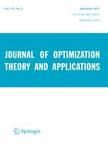版权所有:内蒙古大学图书馆 技术提供:维普资讯• 智图
内蒙古自治区呼和浩特市赛罕区大学西街235号 邮编: 010021

作者机构:Cent S Univ Changsha Hunan Peoples R China Curtin Univ Perth WA 6845 Australia Shanghai Univ Engn Sci Shanghai Peoples R China
出 版 物:《JOURNAL OF OPTIMIZATION THEORY AND APPLICATIONS》 (优选法理论与应用杂志)
年 卷 期:2016年第169卷第3期
页 面:876-901页
核心收录:
学科分类:1201[管理学-管理科学与工程(可授管理学、工学学位)] 07[理学] 070104[理学-应用数学] 0701[理学-数学]
基 金:National Natural Sciences Foundation of China [61403428, 11471211, 71221061] Australia Research Council
主 题:Time-delay Optimal control Control parameterization Time-scaling transformation Time-delay control system Computational method for optimal control
摘 要:In this paper, we consider a class of nonlinear time-delay optimal control problems with canonical equality and inequality constraints. We propose a new computational approach, which combines the control parameterization technique with a hybrid time-scaling strategy, for solving this class of optimal control problems. The proposed approach involves approximating the control variables by piecewise constant functions, whose heights and switching times are decision variables to be optimized. Then, the resulting problem with varying switching times is transformed, via a new hybrid time-scaling strategy, into an equivalent problem with fixed switching times, which is much preferred for numerical computation. Our new time-scaling strategy is hybrid in the sense that it is related to two coupled time-delay systems-one defined on the original time scale, in which the switching times are variable, the other defined on the new time scale, in which the switching times are fixed. This is different from the conventional time-scaling transformation widely used in the literature, which is not applicable to systems with time-delays. To demonstrate the effectiveness of the proposed approach, we solve four numerical examples. The results show that the costs obtained by our new approach are lower, when compared with those obtained by existing optimal control methods.